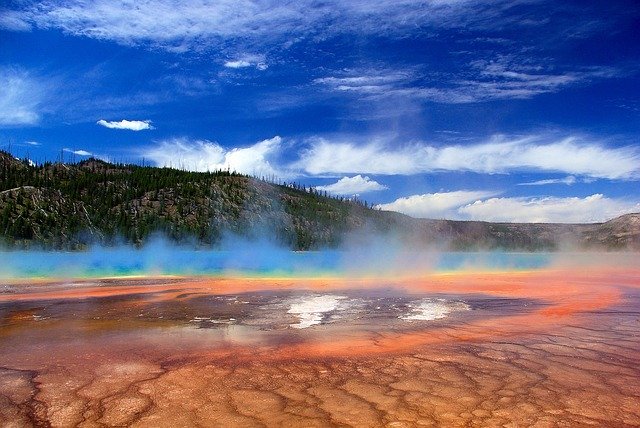Observing nature carefully makes us aware of how small we human beings are. In fact, if we compare ourselves with the imposing mountains, with a strong lightning or the impressive waves of the sea, we realize that we are nothing more than a thin layer of dust that is on the surface of a table.
In other words, we are nothing. This fact is evidenced by the fact that we cannot do anything in the face of a natural disaster. Many times these disasters cannot even be predictable. It is true that, in many cases, tragedies usually occur due to the negligence of the same people.
For example, they build houses on the banks of slopes or ravines, near rivers whose flow tends to grow a lot in the rainy season, they make large buildings in seismic zones and even form small colonies in places where there are active volcanoes. Despite the fact that these volcanoes emit smoke and ash, people remain immobile in their homes.
Due to this lack of awareness, as soon as the earth manifests itself, great tragedies occur, hundreds and even thousands of lives are lost.
Speaking specifically of the case of volcanoes, these are elements that are rarely the protagonists of natural disasters. However, when they do, they are truly devastating.
There are people who are dedicated to the study of these great colossi. They are fascinated by their nature, their behavior, their structure and, for this reason, they even risk their lives, in order to delve deeply into them.
Would you like to learn about volcanoes without taking the slightest risk? This article has been written with the purpose of being able to learn everything related to volcanism. If you are interested, we recommend that you read it from beginning to end to increase your knowledge.
Instructions
- Volcanism is understood as the set of processes that are related to the transformations suffered by magma, or molten rocks, from when it is found inside the earth until it is expelled towards the surface.
- It is one of the largest internal energy manifestations on the entire globe. This force mainly affects areas that are unstable in its crust.
- Volcanoes are nothing more than points of relief that have the function of communicating the earth’s surface with the inner layers of the crust. It is there where, due to the high temperatures, the rocks are completely melted.
- Due to these high temperatures, during periods of activity, the weakest areas of the earth’s crust break apart. This is the root cause of eruption processes.
- In this process, volcanoes expel a large amount of materials. Some of them occur in liquid or semi-liquid form, such as lava. Others, in solid form, such as ash, volcanic bombs, small particles or gravel.
- However, these materials can also be in gaseous form. In relation to this, they can be very varied and contain elements with sulfur, chlorine, oxygen, carbon, hydrogen, among others.
- Volcanoes usually develop in mountain ranges that are in the process of being created, but also in dislocated bases. Never in basins that are already sedimentary. This allows us to take into account that volcanism is related to tectonic zones.
- In order for the magma to come to the surface, it must be close to it so that it can take advantage of the dislocations. On top of that, there needs to be an imbalance between pressure and temperature.
- Depending on the nature of the eruption, the volcanic activity can be classified as Hawaiian, Pelean, Vesuvian, Vulcanic, Icelandic, Plinian, and Strombolian.
- It is interesting to point out the fact that volcanism is not only present on planet earth, it is a process that is universal and cosmic. That is, on other planets, and even in the universe as such, it also manifests itself.
- In fact, in the solar envelope you can see spots through which huge flames of volatile materials come out, which reach thousands of kilometers in height.
- As for the moon, a great variety of craters of volcanoes that are already extinct can be seen on it, and on Mars, scientists have confirmed that there is the presence of very intense volcanic activity.
- In fact, it is thought that a large number of meteorites and aerolites are the result of volcanic eruptions that took place on the stars.
- It is likely that, until now, you did not know much of the information that we have given you about volcanism. But it is important to note that this is not all we have to say on this subject. You will surely be surprised to know that there are different types of volcanism. In the next subtitle we will be learning a little more about this. Let’s see.
What do you need
- As we pointed out at the end of the previous paragraph, there are different types of volcanism, contrary to what we might think about it. Depending on the position of the ascending magma, we can distinguish two types of volcanism, the intrusive and the extrusive.
- As for intrusive volcanism, you should know that it receives this name when the magma is found within the rock strata. When they solidify, they form structures such as batholiths, laccoliths, dikes and sills or also known as the mantle.
- Now, in relation to extrusive volcanism, this occurs when the output of magma occurs from the surface. In this way the formation of the so-called ridges, volcanoes, fumaroles, geysers and other similar expressions occurs.
- But, it is called extrusive volcanism, to all that output and displacement of magmatic material. However, it should be noted that the greatest manifestation of extrusive volcanism are volcanoes.
- In relation to this, a volcano is nothing more than a cone-shaped mountain, which has formed as a result of volcanic material. In general, its shape is well defined.
- In them, the expulsion of the magma can be slow or violent, depending on the type of magma you have. During the eruption process, gases and water vapor are released, as well as so-called pyroclastic solids, which include dust and ash. In addition to rock fragments and Bombs, which are partially melted blocks that cool in the air and take a round shape.
- The larger materials end up being deposited around the crater, while the smaller ones move to more distant places, which helps to form the mountain.
- But what else should you know about volcanism? Keep reading.
Tips
- Perhaps you associate the word volcano with destruction and, certainly, it is an element of nature that can be devastating. However, it is important to note that volcanism brings many benefits to our planet.
- For example, thanks to the diversity of materials that are ejected in the eruption process, agricultural soils benefit from moisture, which makes them even more fertile. In addition, volcanism has contributed to the formation of mineral resources.
- All this, without taking into account that volcanic activity is accompanied by water and steam, which have played a fundamental role in the formation of the atmosphere, the hydrosphere and the emergence and maintenance of life on earth.
- Of course, as is natural when it comes to volcanism, not everything can be rosy. When volcanic eruptions occur, they cause tremors or earthquakes. In addition, the eruption contaminates the environment of the closest communities, due to the ashes and toxic gases that it emits.
- In other words, volcanism can be a great ally for life, but also the worst of enemies, especially if we are close to home.
